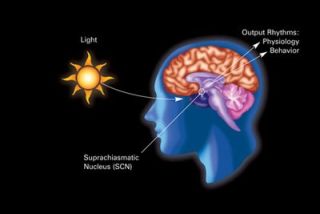Sleep
How Changes of Season Affect Our Behavior
Research on annual, circadian, and infradian rhythms.
Posted February 26, 2023 Reviewed by Jessica Schrader
Key points
- Many animals show seasonal variation in their physiology and behavior, including humans.
- We are also affected by infradian, circadian, and ultradian rhythms.
- There is long-standing disagreement about whether all humans show consistent seasonal variations in complex behaviors.

Spring is finally around the corner, bringing us warmer breezes, blooming trees and flowers, and longer days.
We’ve long recognized that animals often show strong seasonal rhythms in their behaviors, linked to external factors like the length of the day, or the ambient temperature. Hormone levels often fluctuate with the seasons, and behaviors like nest or den building, migration, and food storage peak and ebb across the year.
Psychologists have also wondered about the effect of the changing of the seasons on human minds and bodies, and some seasonal rhythms in some human physiological functions have been noted. For example, there is evidence for seasonal rhythms in blood pressure, cholesterol levels, the number of calories consumed, and even a seasonal fluctuation in birthrate (Bronson, 2004). There is, however, long-standing disagreement about whether humans show, or at least whether all humans show, consistent seasonal variations in more complex behaviors.
Bound by the Light
Seasonal rhythms operate across a relatively long period of time; other rhythms fluctuate fairly quickly, peaking and ebbing away across a period of only 24 hours. These rhythms are called circadian from the Latin “circa diem,” meaning “about a day.” The tendency to be active during daylight hours and to sleep when it’s dark is a circadian rhythm.
And then there are slower, infradian rhythms that fluctuate over a longer period than just one day, like menstruation. Or faster ultradian rhythms that vary several times during a 24-hour period, like the rhythm between slow-wave (non-dreaming) sleep and dreaming sleep (REM sleep), which cycle about every 90 minutes during the night.
Annual and circadian rhythms are tied to the amount of sunlight available and, in turn, are monitored by a region of the hypothalamus called the suprachiasmatic nucleus or SCN. Cells in the SCN get direct input from the retina via the optic nerve about the amount of light available in the world around us. In turn, the SCN then serves as the master timekeeper or pacemaker for circadian and seasonal rhythms in our bodies and our minds.
As the sunlit day fades into darkness, the SCN signals the pineal gland to release a hormone called melatonin, which in turn begins the shift of the brain from wakefulness to sleep. The return of the light at the break of day signals the end of melatonin secretion and the beginning of wakefulness.

Light levels have repeatedly been shown to affect our sleep-wake cycling across a day and annually. Seidler, Weihrich, Bes, de Zeeuw and Kunz (2023) found that total sleep time and the typical 90-minute rhythm between non-dreaming and dreaming sleep were affected by seasonal variations in exposure to light. In their study, total sleep time peaked during the winter months and was shorter in the spring, while dreaming sleep and slow wave sleep were affected by the seasons.
Dreaming sleep peaked twice during the year, in the spring and again in the fall, with significant decreases in deep winter and early autumn. Slow-wave or non-dreaming sleep was more stable across the year but did show significant peaks between December and May and a reduction in the early fall.
Seasonal Thinking?
Meyer, Muto, Jaspar, Kusse, Lambot, Chellappa, et al., (2016) found that cognitive function, as measured on a sustained attention task, tended to peak around the summer solstice and to hit a minimum near the winter solstice. That same study found that performance on a working memory task was also seasonal, but with a peak around the autumn equinox and a nadir at the spring equinox.
The authors speculate that the difference in the timing of these peaks and valleys in function (differences in phase) might have to do with the complexity of the external cues to which the behaviors are tied. Attention might be more tightly related to very basic aspects of the environment, like changes in the amount of sunlight across the year. Other cognitive processes, like working memory function, might be tied to or governed by more complex social cues in our world like our interactions with other people and even cultural cues, like when we tend to go on vacation.
The variability in the measures taken in these studies is high, which may account for some of the disagreement among labs about the effects of seasons on our behaviors. Bronson (2004) proposes that this inconsistency in finding significant results may be due to inconsistencies across individual humans in their susceptibility to the cues of the seasons. Changes in our world, such as the availability of artificial illumination no matter the time of year or the time of day, may have produced some individuals who are less sensitive to the availability of light than others.
There is even evidence that seasonal and circadian rhythms in epigenetic gene expression might be linked, as contributors to, or consequences of, catastrophic diseases like Alzheimer’s disease (Lim, et al., 2017).
Facebook/LinkedIn image: Jirahappiness Gurle/Shutterstock
References
Bronson F.H. (2004). Are humans seasonally photoperiodic? Journal of Biological Rhythms 19(3): 180–192.
Lim, A.S.P., Klein, H.-U., Yu, L., Chibnik, L.B., Ali, S., Xu, J., Bennett, D.A., and De Jager, P. (2017). Diurnal and seasonal molecular rhythms in human neocortex and their relation to Alzheimer’s disease. Nature Communications, 8, 14931, doi: 10.1038/ncomms14931.
Meyer, C., Muto, V., Jaspar, M., Kusse, C., Lambot, E., Chellappa, S.L., Degueldre, C., Balteau, E., Luxen, A., Middleton, B., Archer, S.N. Collette, F., Dik, D.-J., Phillips, C., Maquet, P., and Vanderwalle, G. (2016). Seasonality in human cognitive brain responses. Proceedings of the National Academy of Sciences of the United States of America, 113(11). 3066-3071. doi: 10.1073/pnas.1518129113
Seidler, A., Weihrich, K.S., Bes, F., de Zeeuw, J., and Kunz, D. (2023). Seasonality of human sleep: Polysomnographic data of a neuropsychiatric sleep clinic. Frontiers in Neuroscience, 17, 1105233. Doi: 10.3389/fnins.2023.1105233.




